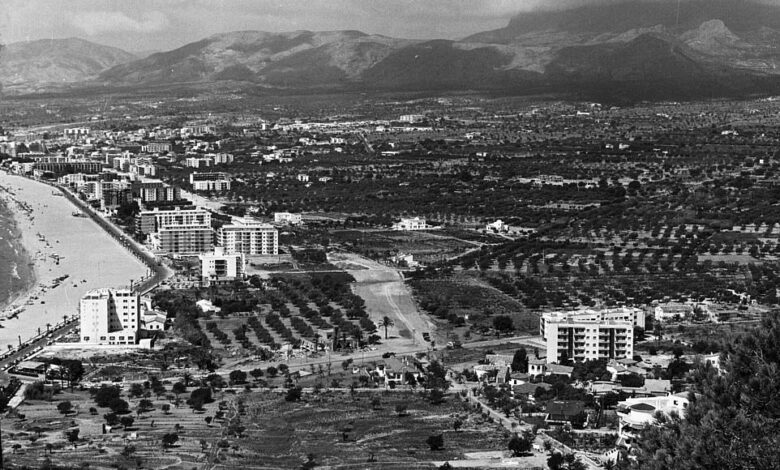Fascinating then-and-now photos show how Spain’s Benidorm transformed from a tiny fishing village into one of Britain’s favourite and brashest package holiday resorts

It’s known today for British pubs, mobility scooters and a popular ITV sitcom, but Benidorm was once a tiny fishing village with barely a tourist in sight. As these fascinating then and now pictures show.
The resort’s first hotel opened in 1926, but Benidorm only turned its full focus on tourism in the 1950s, following the decline of its fishing industry. In 1953, it became the first place in Spain to let women wear bikinis.
With the help of a postwar package holiday boom, and the opening of the El Altet Alicante Airport in 1967, Benidorm earned a place on the map for sun-seeking British tourists.
In the 1970s, huge demand for Spanish holidays led to a building boom, which saw skyscraper hotels pop up across Benidorm’s skyline. Visit Benidorm says ‘hotels were built in record time to meet demand’ with many of the large building projects known as ‘hotel factories’.
Despite its humble roots, Benidorm is today one of the UK’s leading holiday destinations with Tripadvisor naming it Britain’s top trending hotspot in 2023. In that year, more than 2.7million tourists visited the destination for a holiday.
Scroll down to behold Benidorm’s remarkable transformation…

This image dates back to 1964, shortly after Benidorm’s mayor at the time, Pedro Zaragoza, had begun his tourism-boosting ‘General Plan for Urban Organisation’ in the town. Zaragoza is widely credited with the birth of Benidorm as a tourist resort and the ambitious mayor even took on dictator General Franco in 1953 to ensure that bikinis were allowed on the coastal town’s beaches. The former mayor, who died in 2008, told The Independent: ‘If you build low, you occupy all the space and have a long walk to the beach. If you build high, you can face the sea, and leave room for gardens, pools and tennis courts’


The top image, captured in 1964, shows one of the town’s main beaches already busy with tourists. Although it might look packed in this photo, the town’s tourist industry was about to take off even further with the arrival of tour groups from the UK

![The top photograph, from 1964, shows the Spanish resort before the skyscraper building boom of the '70s. The beach was once backed by low-rise buildings and vegetation. Thankfully, despite its tall buildings, more than 30 per cent of Benidorm's territory is still green space, as seen in the bottom photo, reflecting Zaragoza's vision for the town to have space for residents to relax in. Beninter, an apartment rental company, describes Benidorm as 'the opposite of what many may think, [it's] a benchmark of a sustainable urban model'](https://i.dailymail.co.uk/1s/2024/07/09/11/87102259-13615273-image-a-9_1720519451756.jpg)
The top photograph, from 1964, shows the Spanish resort before the skyscraper building boom of the ’70s. The beach was once backed by low-rise buildings and vegetation. Thankfully, despite its tall buildings, more than 30 per cent of Benidorm’s territory is still green space, as seen in the bottom photo, reflecting Zaragoza’s vision for the town to have space for residents to relax in. Beninter, an apartment rental company, describes Benidorm as ‘the opposite of what many may think, [it’s] a benchmark of a sustainable urban model’


The black-and-white image (1963) when compared to the lower photo (2021) shows that the resort’s skyline has dramatically evolved over time – but it does still maintain a well-preserved old town. Jet2 says: ‘With whitewashed houses and the blue-domed San Jaime church, Benidorm Old Town brings you a slice of traditional Spain. Wander around the maze of narrow, cobbled streets, enjoy a leisurely beer and some tapas’


The first image, dating from 1983, shows pensioners enjoying themselves at the beach in Benidorm. El Altet Alicante Airport opened in 1967, making the Spanish resort much more accessible to a whole new market of Britons and foreign tourists. In 1975, the A7 highway opened, connecting Benidorm with more of mainland Europe. In the bottom image (2021), revellers celebrate Benidorm’s annual Fancy Dress Party, which takes place in November. The festival sees thousands take to the streets wearing quirky costumes in a tradition that dates back to the 1990s

Taken in 1963, this image is a snapshot of Benidorm’s lingering fishing industry before the advent of mass tourism. Fishermen in Benidorm practiced almadraba, a traditional Arabic net-fishing technique, used in the Mediterranean to catch bluefish tuna. The industry began declining in the 1950s, prompting the town to focus its economy on tourism

Dating from 1964, this photo shows fishermen at work in Benidorm. The town’s fishermen were known as some of the Mediterranean’s most skilled crews, according to The Property Group

Snapped 60 years ago in 1964, this picture shows a holidaymaker enjoying Benidorm’s beach. Much like today, Benidorm’s primary tourist appeal in the 1960s was its beaches. Visit Benidorm says: ‘Fine golden sand, transparent waters and beaches that are clean and cared for throughout the year are a trademark of the Benidorm seafront.’ In addition to beaches, today’s tourists can also enjoy theme parks, golf courses and a buzzing nightlife scene

This photo was taken in 1964 and shows woven baskets for sale, likely made from esparto grass. A traditional craft technique in Benidorm, the baskets were once used to transport rubble and earth but are now much more commonly touted by tourists as a souvenir from the Spanish resort

Two British men are captured here enjoying a drink in Benidorm in 1984. Despite the passing decades, the resort has maintained its reputation for partying. Hotels.com says: ‘Benidorm is long-established as the Costa Blanca’s brashest beach town, renowned for its unpretentious nightlife, sizeable expat population and ever-bustling stretches of soft golden sand’




